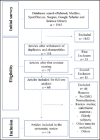Gluteus Maximus Activation during Common Strength and Hypertrophy Exercises: A Systematic Review
- PMID: 32132843
- PMCID: PMC7039033
Gluteus Maximus Activation during Common Strength and Hypertrophy Exercises: A Systematic Review
Abstract
The gluteus maximus (GMax) is one of the primary hip extensors. Several exercises have been performed by strength and conditioning practitioners aiming to increase GMax strength and size. This systematic review aimed to describe the GMax activation levels during strength exercises that incorporate hip extension and use of external load. A search of the current literature was performed using PubMed/Medline, SportDiscuss, Scopus, Google Scholar, and Science Direct electronic databases. Sixteen articles met the inclusion criteria and reported muscle activation levels as a percentage of a maximal voluntary isometric contraction (MVIC). The exercises classified as very high level of GMax activation (>60% MVIC) were step-up, lateral step-up, diagonal step-up, cross over step-up, hex bar deadlift, rotational barbell hip thrust, traditional barbell hip thrust, American barbell hip thrust, belt squat, split squat, in-line lunge, traditional lunge, pull barbell hip thrust, modified single-leg squat, conventional deadlift, and band hip thrust. We concluded that several exercises could induce very high levels of GMax activation. The step-up exercise and its variations present the highest levels of GMax activation followed by several loaded exercises and its variations, such as deadlifts, hip thrusts, lunges, and squats. The results of this systematic review may assist practitioners in selecting exercised for strengthening GMax.
Keywords: Skeletal muscle; electromyography; gluteus maximus; strength training.
© Journal of Sports Science and Medicine.
Figures
References
-
- Andersen L.L., Magnusson S.P., Nielsen M., Haleem J., Poulsen K., Aagaard P. (2006). Neuromuscular activation in conventional therapeutic exercises and heavy resistance exercises: implications for rehabilitation. Physical Therapy 86(5), 683-697. - PubMed
-
- Andersen V., Fimland M. S., Mo D. A., Iversen V.M., Vederhus T., Rockland Hellebø L.R., Nordaune K.I., Saeterbakken A.H. (2018) Electromyographic Comparison of Barbell Deadlift, Hex Bar Deadlift, and Hip Thrust Exercises: A Cross-Over Study. Journal of Strength and Conditioning Research 32(3), 587-593. - PubMed
-
- Aspe R.R., Swinton P.A. (2014) Electromyographic and kinetic comparison of the back squat and overhead squat. Journal of Strength and Conditioning Research 28(10), 2827-36. - PubMed
-
- Baker P. J., Hapuarachchi K. S., Ross J. A., Sambaiew E., Ranger T. A., Briggs C. A. (2014). Anatomy and biomechanics of gluteus maximus and the thoracolumbar fascia at the sacroiliac joint. Clinical Anatomy 27:234–240. - PubMed
-
- Beardsley C., Contreras B. (2014) The increasing role of the hip extensor musculature with heavier compound lower-body movements and more explosive sports actions. Journal of Strength and Conditioning Research 36(2), 49-55.
Publication types
MeSH terms
LinkOut - more resources
Full Text Sources
Miscellaneous


